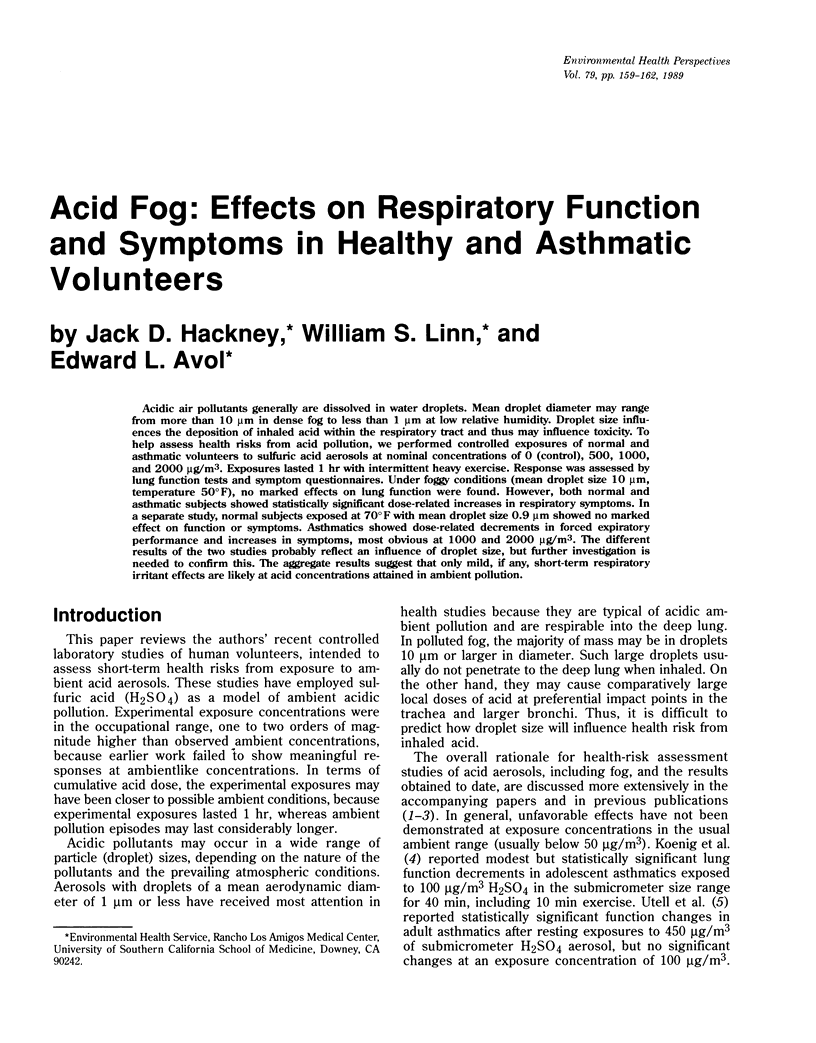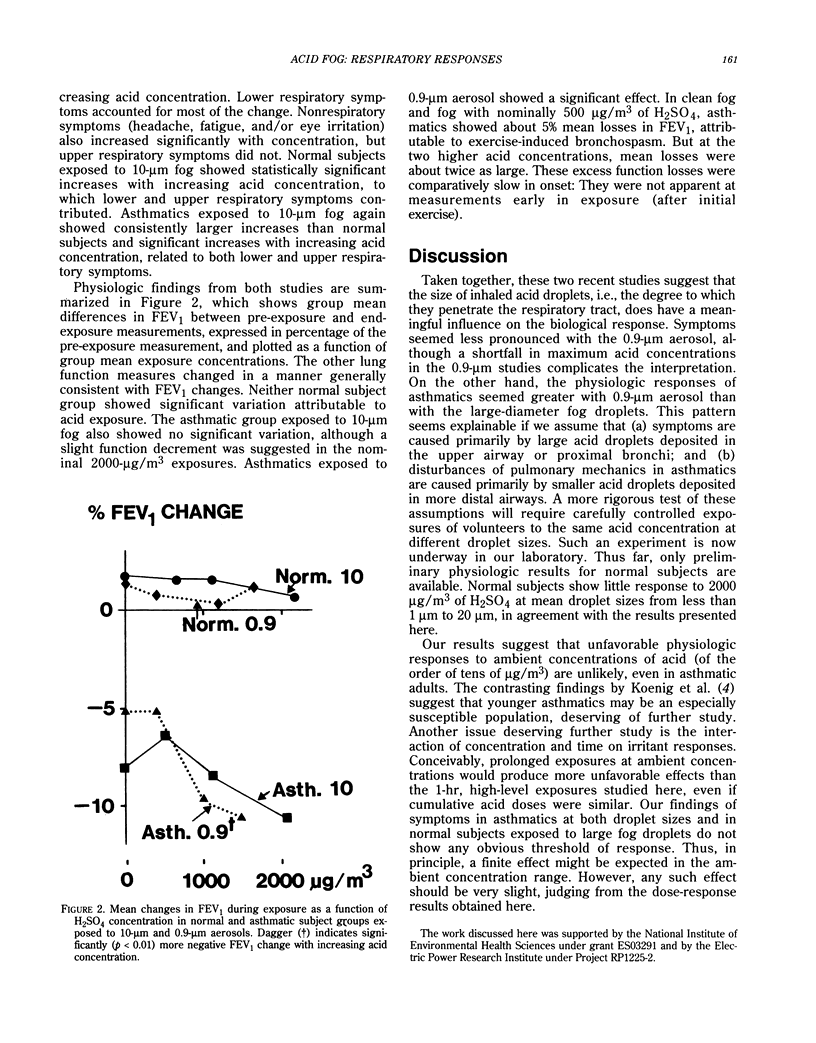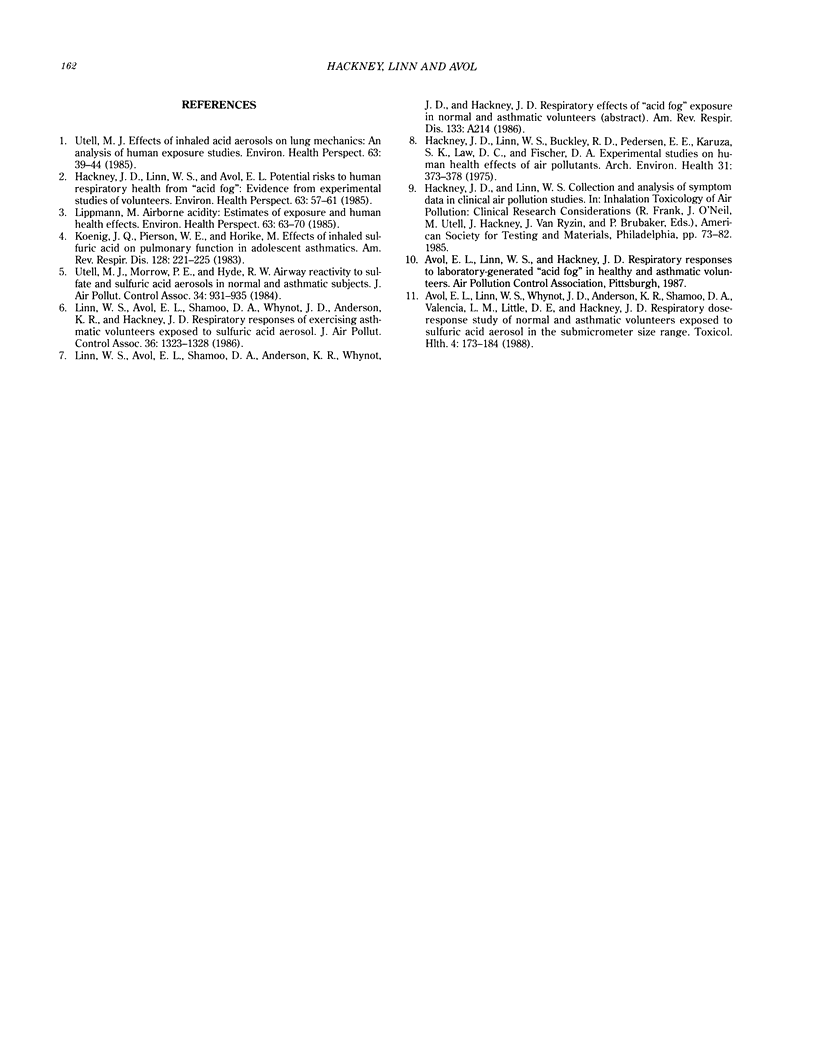Abstract
Acidic air pollutants generally are dissolved in water droplets. Mean droplet diameter may range from more than 10 microns in dense fog to less than 1 micron at low relative humidity. Droplet size influences the deposition of inhaled acid within the respiratory tract and thus may influence toxicity. To help assess health risks from acid pollution, we performed controlled exposures of normal and asthmatic volunteers to sulfuric acid aerosols at nominal concentrations of 0 (control), 500, 1000, and 2000 micrograms/m3. Exposures lasted 1 hr with intermittent heavy exercise. Response was assessed by lung function tests and symptom questionnaires. Under foggy conditions (mean droplet size 10 microns, temperature 50 degrees F), no marked effects on lung function were found. However, both normal and asthmatic subjects showed statistically significant dose-related increases in respiratory symptoms. In a separate study, normal subjects exposed at 70 degrees F with mean droplet size 0.9 microns showed no marked effect on function or symptoms. Asthmatics showed dose-related decrements in forced expiratory performance and increases in symptoms, most obvious at 1000 and 2000 micrograms/m3. The different results of the two studies probably reflect an influence of droplet size, but further investigation is needed to confirm this. The aggregate results suggest that only mild, if any, short-term respiratory irritant effects are likely at acid concentrations attained in ambient pollution.
Full text
PDF



Selected References
These references are in PubMed. This may not be the complete list of references from this article.
- Avol E. L., Linn W. S., Whynot J. D., Anderson K. R., Shamoo D. A., Valencia L. M., Little D. E., Hackney J. D. Respiratory dose-response study of normal and asthmatic volunteers exposed to sulfuric acid aerosol in the sub-micrometer size range. Toxicol Ind Health. 1988 Jun;4(2):173–184. doi: 10.1177/074823378800400203. [DOI] [PubMed] [Google Scholar]
- Hackney J. D., Linn W. S., Avol E. L. Potential risks to human respiratory health from "acid fog": evidence from experimental studies of volunteers. Environ Health Perspect. 1985 Nov;63:57–61. doi: 10.1289/ehp.856357. [DOI] [PMC free article] [PubMed] [Google Scholar]
- Hackney J. D., Linn W. S., Buckley R. D., Pedersen E. E., Karuza S. K., Law D. C., Fischer A. Experimental studies on human health effects of air pollutants: I. Design considerations. Arch Environ Health. 1975 Aug;30(8):373–378. doi: 10.1080/00039896.1975.10666728. [DOI] [PubMed] [Google Scholar]
- Koenig J. Q., Pierson W. E., Horike M. The effects of inhaled sulfuric acid on pulmonary function in adolescent asthmatics. Am Rev Respir Dis. 1983 Aug;128(2):221–225. doi: 10.1164/arrd.1983.128.2.221. [DOI] [PubMed] [Google Scholar]
- Linn W. S., Avol E. L., Shamoo D. A., Whynot J. D., Anderson K. R., Hackney J. D. Respiratory responses of exercising asthmatic volunteers exposed to sulfuric acid aerosol. J Air Pollut Control Assoc. 1986 Dec;36(12):1323–1328. doi: 10.1080/00022470.1986.10466181. [DOI] [PubMed] [Google Scholar]
- Lippmann M. Airborne acidity: estimates of exposure and human health effects. Environ Health Perspect. 1985 Nov;63:63–70. doi: 10.1289/ehp.856363. [DOI] [PMC free article] [PubMed] [Google Scholar]
- Utell M. J. Effects of inhaled acid aerosols on lung mechanics: an analysis of human exposure studies. Environ Health Perspect. 1985 Nov;63:39–44. doi: 10.1289/ehp.856339. [DOI] [PMC free article] [PubMed] [Google Scholar]
- Utell M. J., Morrow P. E., Hyde R. W. Airway reactivity to sulfate and sulfuric acid aerosols in normal and asthmatic subjects. J Air Pollut Control Assoc. 1984 Sep;34(9):931–935. doi: 10.1080/00022470.1984.10465838. [DOI] [PubMed] [Google Scholar]


